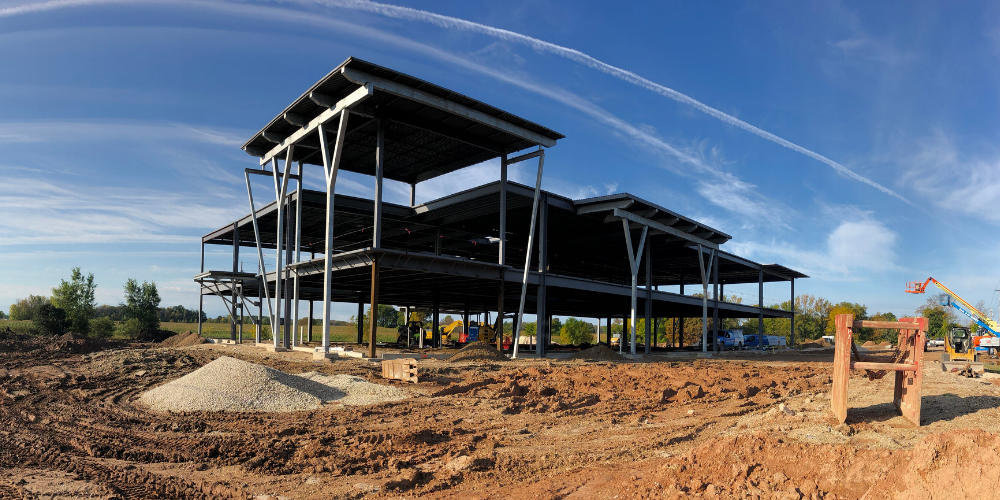How will the construction market impact your credit union?
A Q&A with La Macchia Group’s construction expert and President, Tom Kennedy.

With nearly four decades in the construction industry, Tom Kennedy has seen a lot, done a lot and guided clients and institutions through both times of recession and major construction booms. As President of La Macchia Group, Tom’s knowledge and experience have equipped him to guide financial institutions through post-pandemic investments in their physical and/or digital footprint.
With this in mind, we sat down with Tom to gather and share his insights:
Throughout the pandemic, La Macchia Group encouraged financial leaders to adapt and continue investing in their physical and digital infrastructure. Over a year later, as we “return to normal,” what did you see and what have we learned?
Back in March when things started to take a major shift, we started sharing resources to provide financial leaders with insights to navigate the pandemic. In one of our whitepapers, we outlined the advantages of making smart investments in the midst of economic uncertainty, drawing parallels to those who made capital investments in the Great Recession and came out ahead of those who didn’t. The findings of that initial white paper have certainly proven to be true over this past year as well. As we said at the time, the credit unions that approached the pandemic as a catalyst for action and adaptation were going to thrive, and we’ve seen that play out. Unfortunately, many credit unions, and businesses in general, took the “wait and see” approach, and for very good reason, but now that we’re turning a corner, they’re facing inflation and a lot of pent-up demand. Now, leaders want to build or renovate, and they want to do it now, before it costs even more to do so.
What is your advice to the credit unions that were in the “wait and see” camp, that now feel the urgency to pursue a building project?
My first bit of advice is don’t skip the strategy.
I understand that time is of the essence, as we see inflation increasing, but it is always worth doing the upfront analysis to do it right. You need to understand the marketplace, your brand, your relationship with current and prospective members and ensure these insights inform your next step forward. Now is the time for action, but not at the expense of analysis.
Many people focus on the bricks and mortar of a project, on the dollars and cents of construction, but we can’t forget the human element of the service that credit unions provide. The goal of any building project should be to bring a credit union’s brand, mission and vision to life in a relevant way for your marketplace and your members. If you don’t have a clear path forward for your institution’s brand, mission, and vision – a building project is not worth your investment.
My second is to partner with a design-builder.
I think that now more than ever, a design-build partner is the right choice for credit unions. I won’t hide my bias for design-build vs. a general contractor. I’ve built my career on my passion for the design-build experience, but this moment has brought the design-build benefits to the forefront. Construction costs and material availability is changing rapidly, so CU leadership needs the real-time intelligence and quick pace that the design-build process provides.
You need to know about costs and options along the way, not after a design is complete. With traditional design, you spend months coming up with a concept and then you go to the marketplace to get pricing – and that means several months could have passed and with current inflation rates, that could mean a five to ten percent increase in your costs. With a design builder, you can procure commodities at earlier stages in the process and incorporate market conditions into the actual design. For example, we’re currently working on a project in Florida where we’re not yet done with the design, but we have enough of an understanding of the need for materials that we are already procuring steel, precast and glass. Doing so at this stage in the process means we are saving the client money and giving them a more comprehensive and accurate idea of project costs and timelines.
What does the pent-up demand in the construction industry mean for credit union leaders?
The sheer volume of construction projects is significant. In fact, the construction industry is set to grow by 5.2% in 2021. Unlike many industries, the pandemic did not slow construction overall, even though many firms didn’t make it through. It was an essential industry from the start and now there’s another wave of spending with infrastructure funding. There are a limited number of organizations building buildings – that pent up demand is having a major impact on the industry.
Just 18 months ago, I would have characterized the construction market as a “buyer’s market.” Today, it’s the opposite. The competitive market in the construction industry is different. There are fewer players able to deliver projects and if you need something done, odds are you’re going to have to get in line. It means that builders will have to be selective about the projects they take on and will partner with clients who have a clear vision they’re excited about and engaged by.
What industry trends are you following today? What should CU leaders be considering as they weigh investment opportunities?
Everyone is talking about inflation – and they should be, but in our industry, it’s more complex than what you’re hearing from the federal government. The materials that make up a building are different from what’s included in the general inflation rate for the country. We look at copper, lumber, paint and more; it determines our next steps and influences our design work with clients. We’re very focused on the building supply chain. For example, bar joists are something that’s needed for standard roofs in commercial buildings. Right now, bar joists are backordered resulting in a timeframe that is out of line with most customers’ expectations. So, knowing that upfront, we’re pivoting and finding new, innovative ways to design. We’re designing buildings without bar joists. Instead, we’ll leverage precast or industrial steel based on our supplier relationships and what is available in real-time.
What is the difference between a design-build partner like La Macchia Group and a general contractor? Does it matter?
This is a topic I’m very passionate about. There is a big difference between design-build and a general contractor. We’ve already talked through some of those differentiators, but I think overall it really comes down to collaboration. Collaboration not only between the owner and the design builder, but also within the design-build process. Unlike with general contracting, with a design-builder there aren’t rigid steps in the process that require handoffs to different subcontractors. With a design-builder, the process happens under one roof and often around one table. That means we can and do identify and mitigate challenges upfront, and creatively maximize time and talent, while enhancing transparency with the owner along the way.
What questions about your future projects are keeping you up at night? Ask Tom at Info@LaMacchiaGroup.com.
Tom Kennedy is President of La Macchia Group. Through its proven methodology of Plan – Brand – Design – Build – Evolve, La Macchia Group designs and builds market-driven, brand-centered financial institutions, tailored to meet each client’s unique needs. Tom’s more than 30-years in the design-build industry, and his problem-solving, solutions-driven approach ensure the highest degree of quality for La Macchia Group’s clients.





